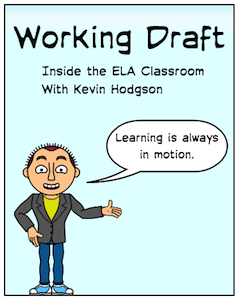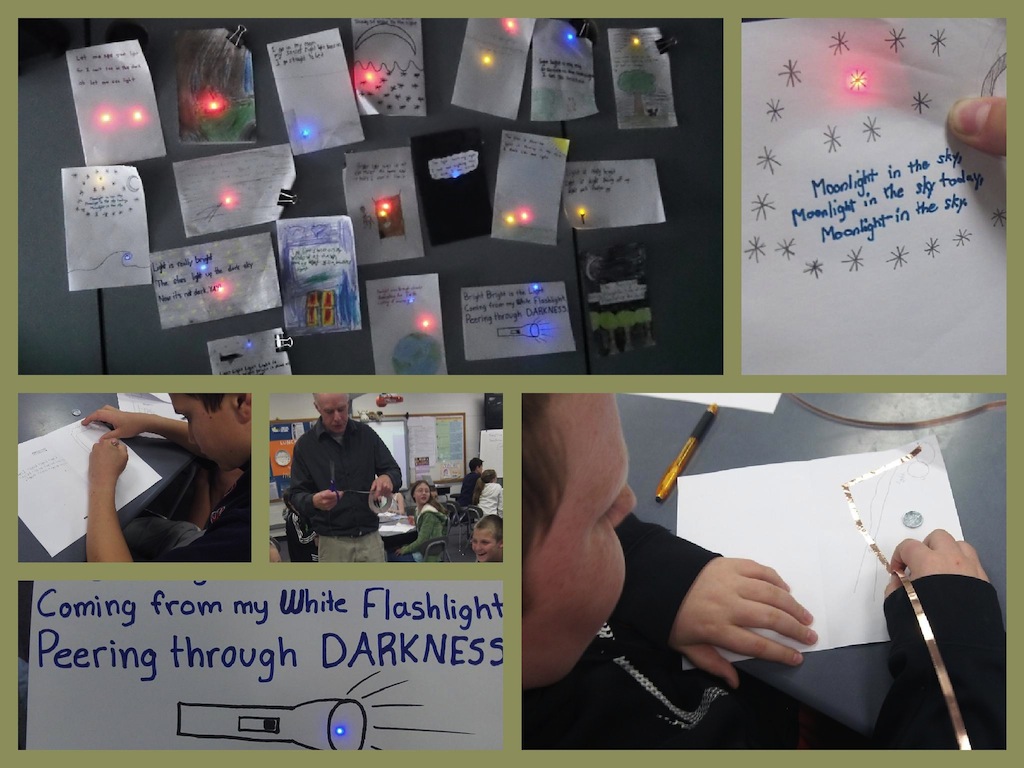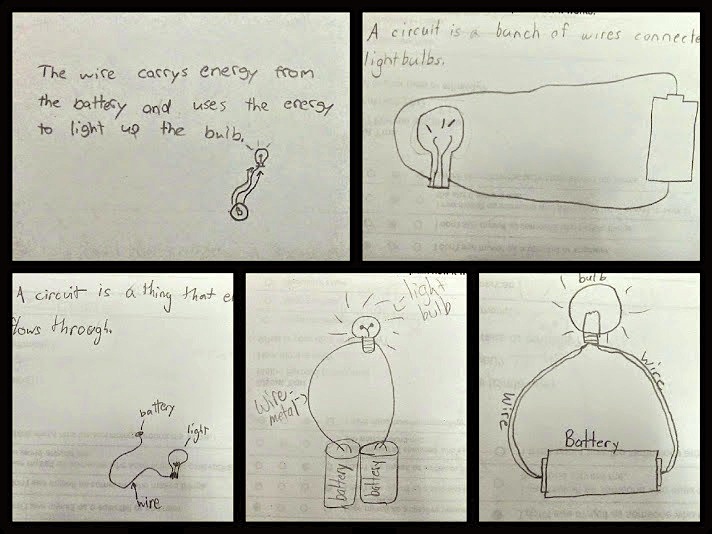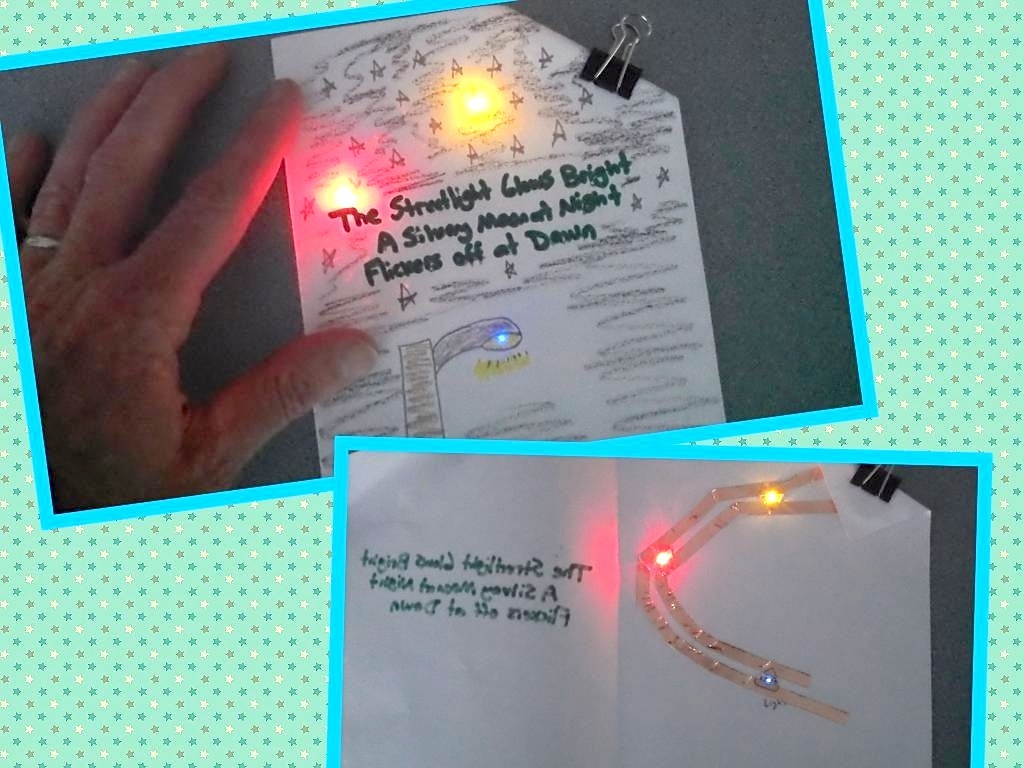Students Illuminate Their Ideas with Paper Circuitry
A MiddleWeb Blog
 There was a shout from the far corner of the room.
There was a shout from the far corner of the room.
“I got it! I got it to work! Check … it … out.”
All eyes turned towards this sixth grader, who held up her light-themed haiku poem like Vanna White on Wheel of Fortune, using fingers to showcase her writing, now glowing with bright yellow and red LED lights.
There was a collective classroom cheer and then everyone quickly turned back to their own poetry projects, carefully running copper conductive tape along paths on paper so that they, too, could light up their words and pictures.

Tinkering with notebooks
My sixth grade class was fortunate to have been chosen to run a pilot project for a Paper Circuitry idea that comes from the inventive mind of Jie Qi, a doctoral student at the MIT Media Lab in Boston (who earned her mechanical engineering degree at Columbia University). A group of folks at NEXMAP, CV2, and the National Writing Project are helping to bring Qi’s ideas to fruition, with the goal of revolutionizing thinking about the role of writing notebooks.
Jie Qi’s Paper Circuitry concept is anchored on the innovation of adding electronic components right into the notebook space itself with flexible wiring and conductive stickers. Qi’s quest harks back to the roots of exploration and discovery when tinkering was an important ingredient of the learning process.
Our experiments are reminding us that – then and now – scientists and inventors use notebooks to collect and analyze data on a regular basis, trying out ideas on paper that might either fail spectacularly or lead to other innovative possibilities.
I first learned about Qi’s work during a workshop session led by Jennifer Dick of NEXMAP, David Cole of CV2, and Paul Oh of the National Writing Project, at the Digital Media and Learning Conference in Boston earlier this year.
Another educator, Natalie Freed, has also been involved in the development of the paper circuitry idea, bringing in a computer science and visual artist perspective. This hands-on session allowed us educators to imagine and reflect upon how we might engage young writers and thinkers in an interesting way. I jumped at the chance to try it out with my sixth graders.
The science of illuminated poetry
For us, in class, the project began with the scientific question of “What is a circuit?”
Luckily, the school’s fifth grade science teacher presents a whole unit on energy and electricity, which culminates in a Maker’s Movement-style project in which students build electric fans out of “found machine parts,” using what they know about circuits to make the fan blow cool air on a hot summer day.
As a result, my sixth graders have a rudimentary understanding of simple circuits from last year’s lessons. So we dove into parallel circuits, too, as this concept would be necessary to grasp as students sought to put more than one LED light into their poem.
The haiku became the centerpiece of our writing assignment, and I purposely chose a light-themed poem. This allowed students to decorate their short, focused poems while also giving them a chance to think about and plan out where they wanted the light to shine through in their writing.
As part of the pilot program, I received special LED stickers that Qi and others are developing but which are not yet on the market. I had to supply my class with the batteries (small, round watch batteries), copper conductive tape, and binder clips (which hold the battery in place). After spending parts of the week talking and working with the idea of simple and parallel circuits, we got to work one afternoon.
My class is an inclusion class, of mixed abilities and needs, so I took some time going through the instructions of creating the paper circuit board (which is really just the copper tape, battery and one or more LED lights on paper). I also worked on my own illuminated poem in the days leading up to the lesson, as a mentor text, so that I could share out what a finished project might look like. This also allowed me to play with the circuit ideas, and think about how best to teach it to my students. I identified areas of possible troubleshooting.
Luckily, I also had my co-teacher colleague, Bob Smith, with me for the class period. The two of us were able to help all students with each step. The hardest part of the endeavor for the students was using the copper tape, which all too easily got wrinkled and bent, and sometimes broken, as students attempted to make “turns” on the circuit board. These problems had as much to do with fine motor skills as the thickness of the tape itself.
I suspect that if we did a second round of this project, the manipulations would be easier for them. And when conductive ink pens are on the market (and made affordable), this whole idea of paper circuitry will move to another amazing level. The writing will become the wiring!
In the end, every student’s poem did light up. We had to “rewire” a few poems; troubleshoot battery locations and positive/negative connections, and relocate a few LED light locations for some students, but every single poem was illuminated during the hour-long lesson.
At one point, we turned out the lights in the room, letting the colored haiku poems cast a colorful glow on our faces. I ended up collecting the poems together on a display board, hanging them up in my classroom (as you can see in the first collage above).
As students in my other three classes who were not part of the pilot project entered the room the day after we did our paper circuitry poems, they all stopped and stared at the wall display of illuminated haiku poetry – and almost universally exclaimed – “What is that? Can we do that?”
I turned off the classroom lights each time, satisfied with the sound of collective “ooooooooo”s from intrigued learners.
Interested in paper circuitry? Visit the NEXMAP website for information on resources, tutorials and more.







































This is amazing Kevin. Thank you for sharing the joy & learning from both you and your students, and even their peers. How exciting to be a part of this class project. I am a Visiting Wizard at 3M. One of our kits that we take out to classrooms is Electricity & Circuits. I’m wondering if we could add something like this. Or as it’s own kit maybe? I’m curious as to how long the session took. Could it be done in an hour?
I like your hands on way of teaching. You are learning right along side your students- sometimes just a step ahead. The atmosphere becomes charged (pun intended) with honest excitement, curiosity & learning. What a place for all of us to be.
Hi Rochelle (the wizard!)
That’s a great question about time.
This is a breakdown of my time with the paper circuitry project:
* Short (review) lesson on Circuits: 15 minutes
* Writing poems/making front of project: 25 minutes
* Making paper circuits (with 21 students, inclusion classroom): 60 minutes
We also did two short pre/post surveys with students as part of our pilot project. So that added another 20 minutes or so.
Kevin
Looks cool! Do they use a special kind of paper for this? I was wondering if there would be a fire hazard with just regular paper.
We used regular paper. The LED lights don’t generate heat worth worrying about.
Kevin